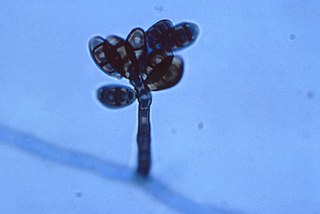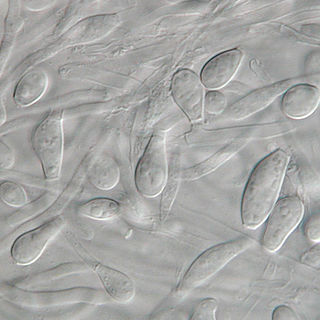
Curvularia is a genus of hyphomycete (mold) fungi which can be pathogens but also act as beneficial partners of many plant species. They are common in soil. Most Curvularia species are found in tropical regions, though a few are found in temperate zones.

Cochliobolus carbonum is one of more than 40 species of filamentous ascomycetes belonging to the genus Cochliobolus. This pathogen has a worldwide distribution, with reports from Australia, Brazil, Cambodia, Canada, China, Congo, Denmark, Egypt, India, Kenya, New Zealand, Nigeria, Solomon Islands, and the United States. Cochliobolus carbonum is one of the most aggressive members of this genus infecting sorghum, corn and apple. As one of the most devastating pathogens of sweet corn, C. carbonum causes Northern leaf spot and ear rot disease while the asexual stage causes Helminthosporium corn leaf spot. Cochliobolus carbonum is pathogenic to all organs of the corn plant including root, stalk, ear, kernel, and sheath. However, symptoms of infection show distinct manifestations in different plant parts: whole plant - seedling blight affects the whole plant, leaf discoloration and mycelial growth, black fungal spores and lesions appear on inflorescences and glumes, and grain covered with very dark brown to black mycelium which gives a characteristic charcoal appearance due to the production of conidia.

Cochliobolus lunatus is a fungal plant pathogen that can cause disease in humans and other animals. The anamorph of this fungus is known as Curvularia lunata, while C. lunatus denotes the teleomorph or sexual stage. They are, however, the same biological entity. C. lunatus is the most commonly reported species in clinical cases of reported Cochliobolus infection.

Setosphaeria rostrata is a heat tolerant fungus with an asexual reproductive form (anamorph) known as Exserohilum rostratum. This fungus is a common plant pathogen, causing leaf spots as well as crown rot and root rot in grasses. It is also found in soils and on textiles in subtropical and tropical regions. Exserohilum rostratum is one of the 35 Exserohilum species implicated uncommonly as opportunistic pathogens of humans where it is an etiologic agent of sinusitis, keratitis, skin lesions and an often fatal meningoencephalitis. Infections caused by this species are most often seen in regions with hot climates like Israel, India and the southern USA.

Acrophialophora fusispora is a poorly studied ascomycete fungus found in soil, air and various plants. A. fusispora is morphologically similar to the genera Paecilomyces and Masonia, but differ in the presence of pigmented conidiophores, verticillate phialides, and frequent sympodial proliferation. Moreover, A. fusispora is distinguished by its pigmented spindle-shaped conidia, covered with spiral bands. The fungus is naturally found in soils of tropical to temperate regions. The fungus has been identified as a plant and animal pathogen, and has recently been recognized as an emerging opportunistic human pathogen. A. fusispora infection in human is rare and has few documented clinical cases, but due to the rarity of the fungus and potential misidentification, the infections may be underdiagnosed. Clinical cases of A. fusispora include cases of keratitis, pulmonary colonization and infection, and cerebral infections. The fungus also has two documented cases of infection in dogs.

Geotrichum candidum is a fungus which is a member of the human microbiome, notably associated with skin, sputum, and faeces where it occurs in 25–30% of specimens. It is common in soil and has been isolated from soil collected around the world, in all continents.

Cercospora melongenae is a fungal plant pathogen that causes leaf spot on eggplant. It is a deuteromycete fungus that is primarily confined to eggplant species. Some other host species are Solanum aethiopicum and Solanum incanum. This plant pathogen only attacks leaves of eggplants and not the fruit. It is fairly common among the fungi that infect community gardens and home gardens of eggplant. Generally speaking, Cercospora melongenae attacks all local varieties of eggplants, but is most severe on the Philippine eggplant and less parasitic on a Siamese variety.

Fonsecaea pedrosoi is a fungal species in the family Herpotrichiellaceae, and the major causative agent of chromoblastomycosis. This species is commonly found in tropical and sub-tropical regions, especially in South America, where it grows as a soil saprotroph. Farming activities in the endemic zone are a risk factor for the development of chromoblastomycosis.
Veronaea is a genus of ascomycete fungi, classified in the family Herpotrichiellaceae. The genus was defined by R. Ciferri and A. Montemartini in 1958.
Coniochaeta hoffmannii, also known as Lecythophora hoffmannii, is an ascomycete fungus that grows commonly in soil. It has also been categorized as a soft-rot fungus capable of bringing the surface layer of timber into a state of decay, even when safeguarded with preservatives. Additionally, it has pathogenic properties, although it causes serious infection only in rare cases. A plant pathogen lacking a known sexual state, C. hoffmannii has been classified as a "dematiaceous fungus" despite its contradictory lack of pigmentation; both in vivo and in vitro, there is no correlation between its appearance and its classification.

Chrysosporium keratinophilum is a mold that is closely related to the dermatophytic fungi and is mainly found in soil and the coats of wild animals to break down keratin. Chrysosporium keratinophilum is one of the more commonly occurring species of the genus Chrysosporium in nature. It is easily detected due to its characteristic "light-bulb" shape and flat base. Chrysosporium keratinophilum is most commonly found in keratin-rich, dead materials such as feathers, skin scales, hair, and hooves. Although not identified as pathogenic, it is a regular contaminant of cutaneous specimens which leads to the common misinterpretation that this fungus is pathogenic.

Cladosporium sphaerospermum is a radiotrophic fungus belonging to the genus Cladosporium and was described in 1886 by Albert Julius Otto Penzig from the decaying leaves and branches of Citrus. It is a dematiaceous (darkly-pigmented) fungus characterized by slow growth and largely asexual reproduction. Cladosporium sphaerospermum consists of a complex of poorly morphologically differentiated, "cryptic" species that share many physiological and ecological attributes. In older literature, all of these sibling species were classified as C. sphaerospermum despite their unique nature. Accordingly, there is confusion in older literature reports on the physiological and habitat regularities of C. sphaerospermum in the strict sense. This fungus is most phylogenetically similar to C. fusiforme. According to modern phylogenetic analyses, the previously synonymized species, Cladosporium langeroni, is a distinct species.
Pithomyces chartarum is a fungus predominantly found in subtropical countries and other localities with warmer climates. However, it occurs throughout the world including the United Kingdom, Europe and Netherlands. Pithomyces chartarum produces a mycotoxin called sporidesmin when it grows on plants, particularly grasses. Presence of the toxin in forage grasses causes facial eczema in sheep, and is especially problematic in areas such as New Zealand where sheep are intensively raised. Other health effect of P. chartarum are not well understood.
Ulocladium chartarum is an ascomycetes mushroom, one of the many in the genus Ulocladium.
Cladosporium herbarum is a common fungus found worldwide in organic and inorganic matter. It is efficiently distributed in the air, where it exists as the most frequently occurring fungal species. It can grow over a wide range of temperatures including very cold environments, giving it the ability to grow on refrigerated meat and form "black spots". Its high prevalence in the air and production of allergens makes C. herbarum an important exacerbant of asthma and hay fever.
Curvularia pallescens is a soil fungus, that commonly grows on crops found in tropical regions. The conidia of the fungus are distinguishable from those of related species due to their lack of curvature. C. pallescens has been reported to cause infection in plants, and in immunocompetent individuals. This species is the anamorph of Cochliobolus pallescens.
Exophiala pisciphila is a mesophilic black yeast and member of the dark septate endophytes. This saprotrophic fungus is found commonly in marine and soil environments. It is abundant in harsh environments like soil contaminated with heavy metals. E. pisciphila forms symbiotic relationships with various plants by colonizing on roots, conferring resistance to drought and heavy metal stress. It is an opportunistic pathogen that commonly causes infections in captive fish and amphibians, while rarely causing disease in humans. Secondary metabolites produced by this species have potential clinical antibiotic and antiretroviral applications.

Alternaria brassicicola is a fungal necrotrophic plant pathogen that causes black spot disease on a wide range of hosts, particularly in the genus of Brassica, including a number of economically important crops such as cabbage, Chinese cabbage, cauliflower, oilseeds, broccoli and canola. Although mainly known as a significant plant pathogen, it also contributes to various respiratory allergic conditions such as asthma and rhinoconjunctivitis. Despite the presence of mating genes, no sexual reproductive stage has been reported for this fungus. In terms of geography, it is most likely to be found in tropical and sub-tropical regions, but also in places with high rain and humidity such as Poland. It has also been found in Taiwan and Israel. Its main mode of propagation is vegetative. The resulting conidia reside in the soil, air and water. These spores are extremely resilient and can overwinter on crop debris and overwintering herbaceous plants.

Mortierella polycephala is a saprotrophic fungus with a wide geographical distribution occurring in many different habitats from soil and plants to salt marshes and slate slopes. It is the type species of the genus Mortierella, and was first described in 1863 by Henri Coemans. A characteristic feature of the fungus is the presence of stylospores, which are aerial, spiny resting spores (chlamydospores).
Curvularia inaequalis is a plant saprobe that resides in temperate and subtropical environments. It is commonly found in the soils of forage grasses and grains. The species has been observed in a broad distribution of countries including Turkey, France, Canada, The United States, Japan and India. This species is dematiaceous and a hyphomycete.











